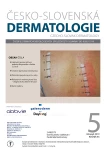Recurrent Melanocytic Lesions – Diagnostically Difficult Cases. Case series
Authors:
T. Fikrle; B. Divišová; J. Šuchmannová; K. Pizinger
Authors‘ workplace:
Dermatovenerologická klinika LF UK a FN Plzeň, přednosta prof. MUDr. Karel Pizinger, CSc.
Published in:
Čes-slov Derm, 94, 2019, No. 5, p. 213-216
Category:
Dermatoscopy
Overview
Recurrent melanocytic lesions arise in a scar by a growth of a lesion, that was not removed completely surgically or by cryodestruction, electrocautery or laser. The main task is to distinguish between recurrent melanocytic nevus and the recurrence of melanoma. The initial histological report, if available, is very helpful. Clinical as well as dermatoscopic images of all recurrent lesions are bizarre. Clinical and dermatoscopic presence of pigmentation beyond the border of the scar is the strongest indication for melanoma. Melanomas usually grow more eccentrically and the pigmentation pattern is chaotic. If there is any suspition of melanoma, surgical excision and histopathologic examination are indicated. Because of the increasing number of recurrent melanocytic lesions arising after aesthetic procedures without histologic examination, this issue is a current topic.
Keywords:
recurrent nevus – melanoma – dermoscopy – scar
Sources
1. BLUM, A., HOFMANN-WELLENHOF, R. Recur-rent nevus or recurrent melanoma. Hautarzt, 2014, 65(11), p. 978–980.
2. BLUM, A., HOFMANN-WELLENHOF, R., MARGHOOB, A. A. Recurrent melanocytic nevi and melanomas in dermoscopy: results of a multicenter study of the International Dermoscopy Society. JAMA Dermatol., 2014, 150(2), p. 138–145.
3. FOX, J. C., REED, J. A., SHEA, C. R. The recurrent nevus phenomenon: a history of challenge, controversy, and discovery. Arch Pathol Lab Med., 2011, 135(7), p. 842–846.
4. HECK, R., FERRARI, T., CARTEL, A. et al. Clinical and dermoscopic (in vivo and ex vivo) predictors of recurrent nevi. Eur J Dermatol., 2009, 29(2), p. 179–184.
5. KORNBERG, R., ACKERMAN, A. B. Pseudomelanoma: recurrent melanocytic nevus following partial surgical removal. Arch Dermatol., 1975, 111(12), p. 1588–1590.
6. LARRE BORGES, A., ZALAUDEK, I., LONGO, C. et al. Melanocytic nevi with special features: clinical-dermoscopic and reflectance confocal microscopic-findings. J Eur Acad Dermatol Venereol., 2014, 28(7), p. 833–845.
7. LEE, H. W., AHN, S. J., LEE, M. W. et al. Pseudomelanoma following laser therapy. J Eur Acad Dermatol Venereol., 2006, 20(3), p. 342–344.
8. TSCHANDL, P. Recurrent nevi: report of three cases with dermatoscopic-dermatopathologic correlation. Dermatol Pract Concept., 2013, 31(1), p. 29–32.
Labels
Dermatology & STDs Paediatric dermatology & STDsArticle was published in
Czech-Slovak Dermatology

2019 Issue 5
Most read in this issue
- Kožní nádory
- Drug Hypersensitivity Reactions: Diagnosis and Treatment (Part II)
- Linear IgA Bullous Dermatosis. Case Report
- Translucent Papule on the Toe. Minireview
